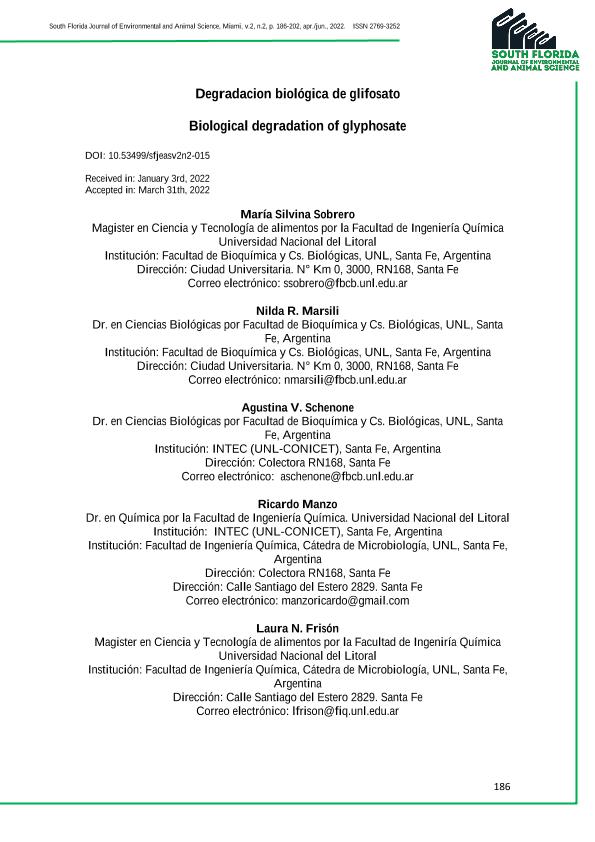Artículo
La necesidad de producir más alimentos ha llevado al aumento del uso de pesticidas, entre ellos glifosato, el cual es ampliamente empleado en la producción de soja transgénica. Esto ha implicado que crezcan los casos de intoxicaciones y contaminación de recursos naturales. Por tal motivo los entes gubernamentales han formulado instrucciones de manipulación y de descarte de los envases comerciales. El objetivo del presente trabajo fue evaluar la capacidad de Candida tropicalis LMFIQ 703 para disminuir la concentración de glifosato en el tercer enjuague de bidones y así reducir el riesgo de impacto ambiental adverso que producen los residuos de pesticida en los envases vacíos almacenados por largos periodos de tiempo. Se sembraron suspensiones de levadura sin adaptación, en soluciones de Credit® Amonio (Ingrediente activo: sal amónica de la N-fosfonometil glicina) con concentración conocida (similar a la del tercer enjuague). Se incubó a 28°C durante 28 días y se realizó el recuento microbiológico de colonias de levadura cada 7 días. La determinación de la concentración de glifosato se hizo por fluorimetría con calibración multivariada y HPLC. Las levaduras se mantuvieron viables durante todo el experimento, con una disminución inicial por adaptación y una concentración final similar a la inicial. Los resultados de la cuantificación de glifosato a través de fluorescencia y calibración multivariada, aprovechando la ventaja de segundo orden del algoritmo MCR-ALS resultaron comparables con los obtenidos por el método de referencia (HPLC). Se puede concluir que la biorremediación propuesta fue eficiente ya que la concentración de glifosato disminuyó un 39%. The need to produce more food has led to an increased usage of pesticides. One of them is glyphosate, which is widely used in soybean production. This has implied the growing of cases of intoxication and pollution of natural resource. For this reason, government agencies have formulated instructions for handling and disposal of commercial packaging. The aim of the present work was to evaluate the ability of the yeast Candida tropicalis LMFIQ 703 to decrease the concentration of glyphosate present in the third rinse of the containers, so as to diminish the risk of adverse ambient impact produced by the pesticide residues in empty containers stored for long periods of time. Yeast suspensions were seeded, without adaptation, in Credit Ammonium solutions (Active ingredient: ammonium salt of N-phosphonomethyl glycine) of known concentration (similar to the obtained in the third rinse). The incubation was done at 28 °C for 28 days. Glyphosate was quantified and the number of colonies was determined at different times. The concentration of the pesticide was done by a fluorimetric method with multivariate calibration as well as by HPLC. Yeasts remained viable throughout the experiment, with an initial decrease because of adaptation and a final concentration similar to the initial. The quantification results of glyphosate by the fluorimetric technique with the aid of the second order advantage achieved by MCR-ALS were comparable with those acquired by the reference method (HPLC). It can be concluded that the proposed bioremediation is efficient since the concentration of glyphosate was decreased by 39%.
Degradacion biológica de glifosato
Título:
Biological degradation of glyphosate
Sobrero, María Silvina; Marsili, Nilda Raquel; Schenone, Agustina Violeta ; Manzo, Ricardo Martín
; Manzo, Ricardo Martín ; Frisón, Laura Noemí
; Frisón, Laura Noemí
 ; Manzo, Ricardo Martín
; Manzo, Ricardo Martín ; Frisón, Laura Noemí
; Frisón, Laura Noemí
Fecha de publicación:
06/2022
Editorial:
South Florida Publishing
Revista:
South Florida Journal of Environmental and Animal Science
e-ISSN:
2769-3252
Idioma:
Inglés
Tipo de recurso:
Artículo publicado
Clasificación temática:
Resumen
Palabras clave:
GLIFOSATO
,
BIORREMEDIACIÓN
,
SALUD
,
MEDIO AMBIENTE
Archivos asociados
Licencia
Identificadores
Colecciones
Articulos(INTEC)
Articulos de INST.DE DES.TECNOL.PARA LA IND.QUIMICA (I)
Articulos de INST.DE DES.TECNOL.PARA LA IND.QUIMICA (I)
Citación
Sobrero, María Silvina; Marsili, Nilda Raquel; Schenone, Agustina Violeta; Manzo, Ricardo Martín; Frisón, Laura Noemí; Degradacion biológica de glifosato; South Florida Publishing; South Florida Journal of Environmental and Animal Science; 2; 2; 6-2022; 186-202
Compartir
Altmétricas



